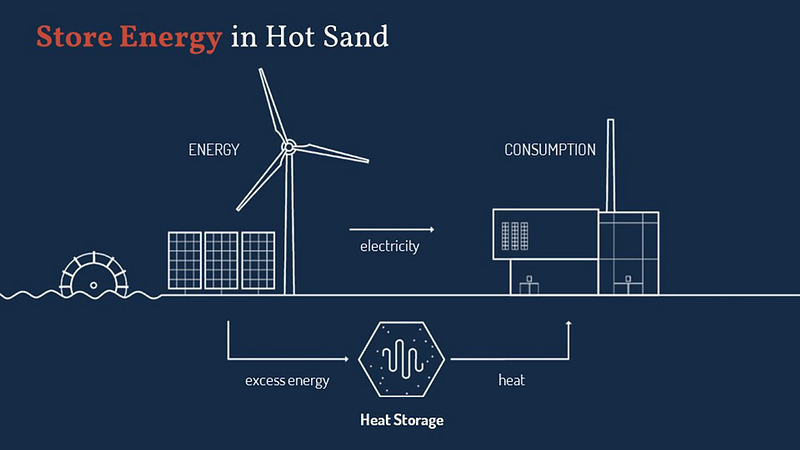# Innovative Sand Batteries: The Future of Energy Storage
Written on
Chapter 1: Understanding Sand Batteries
What Exactly is a Sand Battery?
A "sand battery" refers to a type of thermal energy storage system that employs sand or similar materials to retain energy in the form of heat. This technology is designed primarily to act as a high-capacity reservoir, storing surplus energy generated from wind and solar sources. The heat accumulated in the sand can be utilized to produce steam, provide process heat to various industries, or even warm homes, thereby decreasing dependence on fossil fuels. The concept of the "sand battery" gained notable attention following a BBC News article published on July 5, 2022.
How Does It Operate?
Sand is an effective medium for heat retention and exhibits minimal heat loss over time. A sand battery comprises a tall, gray tower filled with sand, which becomes heated when charged. This process involves passing an electric current through the sand, generating heat. A heat exchanger facilitates the circulation of hot air within the container. While the storage mechanism is straightforward, scientists employ computer technology to monitor the heat levels and assess the rate of energy utilization.
Benefits of Sand Batteries
Sand batteries present numerous advantages, such as their low cost and the widespread availability of sand as a resource. By situating sand battery systems underground, valuable surface land can be preserved for agriculture, housing, and conservation efforts. These batteries can provide essential heating during prolonged cold seasons, decreasing reliance on external energy sources and alleviating the financial burdens associated with fossil fuels. Additionally, they can significantly lower electricity costs when supplying power back to the grid. Sand batteries also facilitate the storage of green energy in heat form, thus reducing various industries' dependence on fossil fuels, especially in sectors like food and beverage, textiles, and pharmaceuticals. By leveraging sand batteries for heat energy storage and distribution, industries can play a vital role in combating climate change.

Challenges Facing Sand Batteries
Despite their potential, sand batteries face several challenges, particularly regarding scalability. It remains uncertain whether this technology can be expanded effectively to create a substantial impact. Moreover, a significant obstacle is the development of technology capable of generating electricity in addition to heat, as that is currently their primary function. There are also environmental concerns related to sand mining and the limited availability of specific sand types that are optimal for energy storage applications.
Commercial Advancements
The world's inaugural commercial sand battery, known as Polar Night Energy, is situated in Kankaanpää, Western Finland, and is integrated into a district heating network that services residential and commercial buildings, including family homes and a municipal swimming pool. In Western Finland, the Vatajankoski power plant has implemented its first sand battery system, designed to supply heat to the district heating network starting in 2022. This innovative sand battery boasts an impressive storage capacity of 100 kW and can retain up to 8 MWh of heat.

Polar Night Energy's groundbreaking sand battery can store heat for weeks or months, offering an eco-friendly and cost-effective energy storage solution. The system converts renewable electricity into hot air, which is then directed into the sand, heating it up for extended periods. The sand battery can maintain temperatures of 500 degrees Celsius for months, making it ideal for district heating systems that warm homes, offices, and swimming pools. The entire setup is remarkably affordable, costing less than €10 per kilowatt-hour. The sand used does not need to be specialized; it merely needs to be dry and devoid of combustible debris, rendering it a low-cost storage medium. Additionally, the entire process is automated, requiring no consumables and operating at minimal costs. The Polar Night Energy sand battery is a simple yet effective solution that is revolutionizing energy storage.
Final Thoughts
I find sand batteries to be an intriguing technology that could offer solutions for regions with low energy demands, particularly those near sandy coastlines. However, I have a couple of lingering questions. Firstly, what type of sand is utilized in these batteries? Is it coarse sand, which is becoming increasingly scarce due to its use in construction, or fine sand found in deserts like the Sahara or Gobi? Secondly, could this technology potentially be adapted for use in managing salination, a byproduct of brine? These questions are thought-provoking, and I hope answers will emerge soon!
Follow me for daily insightful content!
YouTube: www.youtube.com/@tycooperaow
Chapter 2: The Future of Ocean-Based Energy Storage
The Ocean as a Source of Energy Storage
The ocean holds immense potential for energy storage solutions, as demonstrated in various innovative projects.
Batteries Are So Last Year: Meet the Game-Changing Ocean Energy Storage Systems Taking Over
As traditional battery technologies face limitations, ocean energy storage systems are emerging as game-changers, offering sustainable and efficient solutions to modern energy challenges.